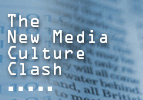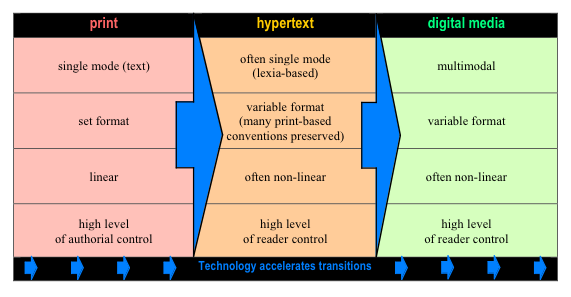




Digital media is the next progression along the continuum. Digital rhetoric provides a framework for making persuasive arguments within that context. As the diagram above illustrates, print-based scholarship that utilized a single mode (written text) and a set format (such as proscribed margins, layout, and style) deployed in a linear fashion preserving a high level of authorial control began to make way for hypertextual argument. As computer technology advanced and CD-ROM access became more commonplace, software such as StorySpace that allowed the inclusion of hypertext links within a composition emerged.
As access to the internet expanded and new software made it easier to develop web pages, hypertext scholarship became more prevalent gaining further acceptance. Now, relatively inexpensive handheld digital video cameras and desktop editing software have moved sound and movie production capabilities from Hollywood studios to the family computer room. Wider accessibility of affordable (even free) image editing software has advanced our ability to engage with the visual in our argumentation. In short, digital tools allow us to embrace multimodal argument in a way never before possible.
Ball critiques a 2002 Kairos webtext, “[Continuing to] Mind the Gap: Teaching Image and Text in New Media Spaces,” denying the argument the status of “new media” because its “visual elements do not perform the work of the written argumentative modes” (2004, 407). However, the fact that the video components supplement the argument and add to it demonstrates the power of multimodality. Although it does not break away from the print tradition, the webtext does move us further along the continuum and offers insight as to how video can help persuade. It then becomes a much shorter step for a scholar to see how video (or animation, or sound, or some other modality) could carry the full burden of argumentation.
The pace with which multimedia tools develop may be threatening to some in the field of composition (Westbrook 2006) — and perhaps even some under the larger umbrella of English Studies. An overemphasis on new (experimental) media and a denial of that label to more accessible and familiar digital compositions risks a backlash from scholars unfamiliar and/or uncomfortable with technology and further entrenches our print-centric academic culture. The potential result is a slowing of our movement across the continuum to multimodal digital argument.When the “new” gets old • In the eye of the beholder • Moving across the continuum • Works cited • Home